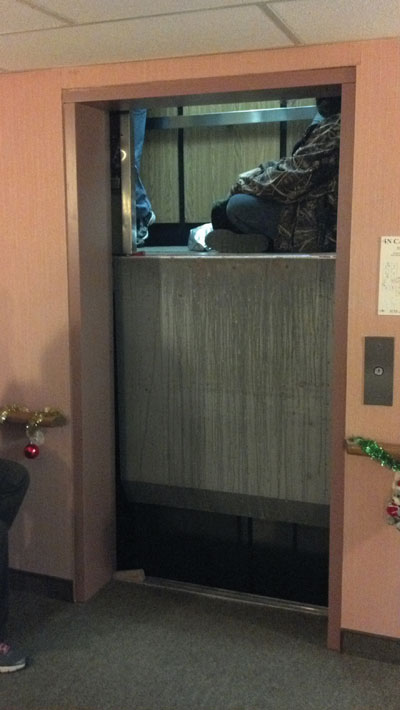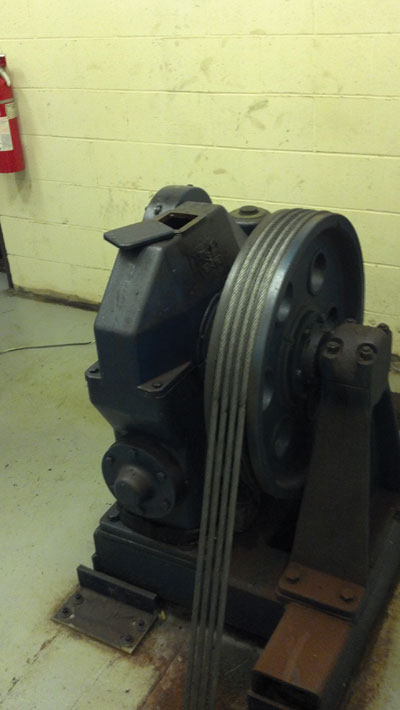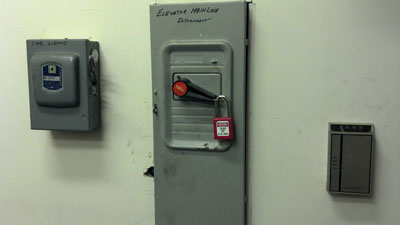
Features
Structural
Training
Back to Basics: March 2013
On Dec. 8, the Woodstock Fire Department (WFD) in Ontario responded to a call for people trapped in an elevator.
March 4, 2013
By Mark van der Feyst
On Dec. 8, the Woodstock Fire Department (WFD) in Ontario responded to a call for people trapped in an elevator. There was no other information about the entrapment given to responding crews. The elevator, located in a five-storey seniors’ residence, was the only elevator servicing the building.
 |
|
| Photo 1: The elevator was stuck between the third and fourth floors, with only a two-and-a-half-foot space through which firefighters could reach occupants. |
|
 |
|
| Photo 2: Door wedges, or chocks, were used to hold both the elevator door and shaft door open. | |
 |
|
| Photo 3: The motor used to operate the elevator overheated due to a mechanical fault and shut down, locking the elevator between floors. |
|
 |
|
| Photo 4: The crew assigned to the elevator mechanical room was locked out of the main power supply to the elevator. | |
 |
|
| Photo 5: A sheet of paper was slipped between the brake pads (the blue square) and the brake drum (the silver steel) to ensure that the brakes were set and locked in place. |
The first apparatus arrived on scene and met with the building superintendent to ascertain more information about the entrapment. At the same time as the other two trucks arrived on scene, another call regarding an automatic alarm was received for the same building.
With the two calls happening at once, two crews were created to deal with each call. The first-arriving crew dealt with the elevator entrapment, while the crews from the other two arriving units dealt with the automatic alarm. The elevator company was called in for its service expertise, with an estimated time of arrival of between one and two hours.
The elevator crew grabbed the elevator rescue equipment, which included a lock-out tag-out box, a flashlight, elevator keys to open the doors, and portable radios for communication. Two crew members from the elevator rescue team went to the third floor, where the elevator was stopped, while the other two crew members – including the officer– went up to the elevator mechanical room.
On the third floor, crew members approached the elevator door. They banged on the elevator door with their hands, before making verbal contact with the occupants. Right away, the occupants were asked whether anyone had any medical problems; this was to ascertain whether there was an immediate need for removal. All three occupants replied that they were OK. The elevator shaft door was opened up using the elevator keys, which are intended for the small circular hole at the top of the door. Once that door was opened, the elevator door was opened. Both doors were kept open by using two door wedges, or chocks, as seen in photos 1 and 2.
As you can see in photo 1, the elevator was stopped between the third and fourth floors. There was a small space of only about two-and-a-half feet available through which rescuers could reach the occupants. All occupants were told to stay in the elevator for their safety until we were certain it was safe to remove them. At the same time, firefighters who had gone to the elevator mechanical discovered a small amount of smoke inside. The smoke detector inside the room had been activated. The motor that operates the elevator had overheated due to a mechanical fault and had shut down, locking the elevator in the position found on the third floor (see photo 3).
The crew assigned to the elevator mechanical room was locked out of the main power supply to the elevator, as seen in photo 4. The officer held the key to the padlock. The elevator’s brakes were checked to make sure that they had locked and were holding the elevator in place. A sheet of paper was used to see if there was any space between the brake pad and the brake drum. The brake pad is the blue square in the middle of photo 5, resting against the shiny steel. The brakes were set and locked in place.
Once all safety systems were in place and had been verified by the officer, and also by WFD’s elevator-rescue instructor, the decision was made to remove the occupants from the elevator. The three occupants were removed from the elevator one at a time without any injury.
The elevator was placed out of service and the padlock was kept in place until the technician from the elevator company arrived. Once the technician arrived, the padlock was removed and replaced.
Although this call was a technical rescue, mixed with a general response call (for the automatic alarm), the situation was handled using basic tactics: establishing communication with the occupants inside the elevator; determining any medical attention that may be needed; locking out the main power supply to the elevator; and communicating all actions between the crews. Having a person trained in elevator rescue made a big difference and will help any crew better execute this type of operation.
Opening the elevator doors is part of the technical-rescue operation. This process can vary, depending on what type of access is available for the fire department or elevator technicians. This particular elevator door had a small hole at the top for the elevator key to open the shaft door. The WFD had trained on that type of elevator door at another facility a few weeks before this incident and this training helped firefighters successfully complete this rescue. Crews had practised opening the door using the various types of elevator keys to see which one worked best. The training, which had also familiarized crews with that type of mechanical operation, paid off as crews were able to quickly open the elevator doors and free the trapped residents.
Mark van der Feyst is a 14-year veteran of the fire service and works for the City of Woodstock Fire Department in Ontario. Mark instructs in Canada, the United States and India and is a local-level suppression instructor for the Pennsylvania State Fire Academy and an instructor for the Justice Institute of B.C. E-mail Mark at Mark@FireStarTraining.com
Print this page